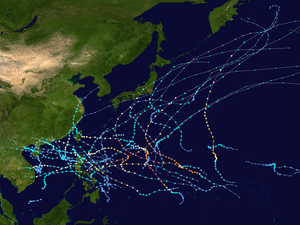| 2009 Pacific typhoon season | |
|---|---|
 Season summary map | |
| Seasonal boundaries | |
| First system formed | January 3, 2009 |
| Last system dissipated | December 8, 2009 |
| Strongest storm | |
| Name | Nida |
| • Maximum winds | 215 km/h (130 mph) (10-minute sustained) |
| • Lowest pressure | 905 hPa (mbar) |
| Seasonal statistics | |
| Total depressions | 41 |
| Total storms | 22 |
| Typhoons | 13 |
| Super typhoons | 5 (unofficial) |
| Total fatalities | 2,348 total |
| Total damage | $10.29 billion (2009 USD) |
| Related articles | |
The 2009 Pacific typhoon season was a below average season that spawned only 22 named storms, 13 typhoons, and five super typhoons. Despite this, it was a very deadly season, with the Philippines having experienced its deadliest season in decades due to the impact of typhoons Ketsana and Parma, while typhoon Morakot went on to become the deadliest storm to impact Taiwan in its modern history. The first half of the season was very quiet, whereas the second half of the season was extremely active. The season's first named storm, Kujira, developed on May 3, while the season's last named storm, Nida, dissipated on December 3.
During August, Typhoon Morakot devastated Taiwan, killing nearly 800 people and being known for being the deadliest typhoon to impact the country. Typhoons Ketsana and Parma both affected the Philippines, bringing extreme flooding that killed more than 1400 people in total. Typhoon Nida during late November reached 1-minute winds of 285 km/h (175 mph), which is the most intense in the basin since Typhoon Paka in 1997.
The scope of this article is limited to the Pacific Ocean to the north of the equator between 100°E and 180th meridian. Within the northwestern Pacific Ocean, there are two separate agencies that assign names to tropical cyclones which can often result in a cyclone having two names. The Japan Meteorological Agency (JMA) will name a tropical cyclone should it be judged to have 10-minute sustained wind speeds of at least 65 km/h (40 mph) anywhere in the basin, whilst the Philippine Atmospheric, Geophysical and Astronomical Services Administration (PAGASA) assigns names to tropical cyclones which move into or form as a tropical depression in their area of responsibility located between 135°E and 115°E and between 5°N–25°N regardless of whether or not a tropical cyclone has already been given a name by the JMA. Tropical depressions that are monitored by the United States' Joint Typhoon Warning Center (JTWC) are given a number with a "W" suffix.